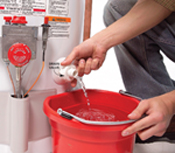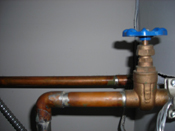Plumbing Tips
Money-Saving Plumbing Tips
 Modern Plumbing & Backflow provides these plumbing tips to help you save money on your water bill and keep your plumbing system running smoothly. Feel free to contact us if you have any questions!
Modern Plumbing & Backflow provides these plumbing tips to help you save money on your water bill and keep your plumbing system running smoothly. Feel free to contact us if you have any questions!
Know the Location & Age of Your Water Heater.
Believe it or not, most people (especially new home owners) have no idea where the hot water heater is in their home. Once you’ve located it, take a look at the label on it (a sticker approximately 3×2’ located on the side of your water heater). Find the serial number. Most manufacturers show the date of when the unit was made in the first four digits of the serial number. For example, lets say the serial number was 09934FR563 – we know it was made in September of 1993. Other manufacturers will list the week and then the year; for instance, 23934FR563. Here we know that the water heater was made on the 23rd week of 1993.
At Modern Plumbing, we tell our clients that the average water heater lasts approximately 9 -11 years before it starts leaking; however, it’s not unheard of to see a water heater 20 years old. We highly recommend homeowners be proactive about replacing their water heater before it leaks to avoid the costly problems a leak can cause. For example, if you have a hot water heater in the attic or in a crawl space, you may not know your water heater is leaking until you notice secondary damage that it has caused or get an unusually high water bill in the mail.
Should I Repair or Replace a Water Heater?
Water heaters typically last 9 -11 years before they leak. Repairing a water heater that has passed its life expectancy is not the best investment. Beware of any plumbing company that recommends that you spend a great deal of money on an older water heater.
How Do I Shut Off My Water Heater?
No matter what water heater you buy, someday it will get old and start leaking if it isn’t replaced first. It’s very important to know how to shut the unit off in case of a leak. If you are looking at the front of the water heater, you will see two pipes at the top (most likely copper or plastic pipe).
On the pipe to the right (the cold water side), you will find a shut off valve. This may be either a gate valve (a round turning valve) or a ball valve (a handle valve). IMPORTANT: Gate valves are sometimes a bit tricky and often aren’t reliable. If you have one of these valves, slowly turn the valve clockwise until it closes. This may require several revelations. Be sure not to turn the valve too tight or with too much force.
To ensure that the hot water is shut off, go to any faucet in the house and turn on the hot water – the water should subside completely. This may take a couple of minutes. If the water doesn’t subside, leave the hot water on in the faucet, return to the water heater and listen carefully for a hissing sound coming from the valve. If you hear one, the valve has not been shut all the way – try opening and closing it several times until it closes tightly.
How Do I Shut Off the Water to My House?
Depending on when your house was built, the shut off valve could be in any one of a number of places – a crawl space, hallway closet, the garage, etc. Most homes in North Carolina have gate valves as the means to shut off water. Gate valves are very unreliable – don’t bother with one! Modern Plumbing recommends you shut your home’s water off at the water meter. Next time you are at a home improvement store, pick up a meter key (approx. $10.00). Don’t get intimidated; you’ll find it very easy to use. First, locate the water meter. Often it is in the front yard under an iron oval cover. Once you have the cover open, look towards the front of the meter and you will see where the meter key fits in. Slowly turn the key to shut off the water.
Toilets Don’t Last Forever!
Most people believe that you can always nurse a broken toilet back to life because it has very few parts. Not always true. Like every other fixture in your home, toilets have a life expectancy. How long a toilet lasts depends on many variables, such has how often it is used and how hard the water is. A sure sign that your toilet’s days are numbered is how uniform the flush is. Try this: Flush your toilet at home, and as the water starts to spin into a vortex check whether it is a tight spin. Also, pay close attention to the speed of the water before it leaves the bowl. Do you see a rocking motion? If you see a rocking motion or you are not getting a tight spin, you toilet may be on its last leg. Why is this? Under the rim of your toilet there are perforated holes approximately one inch apart. If one or more of these holes are clogged, this will hinder the tight vortex of the water. If you see a rocking motion at the end, this is also due to build-up. Unfortunately, the only way to remedy this is to replace the toilet. The good news is that most modern toilets are much more efficient, making them better on the environment and easier on your wallet.
Leaky Faucets
A leaky faucet may cost you big money if not corrected. It’s estimated that one leak dripping at a speed of 20 drips per minute = 694 gallons of wasted water per year. And that’s just a small leak! Don’t forget that if you live in Raleigh or Durham, your bill is split, which means that not only do you pay for the water but you also pay for the drainage on that water.
Why is My Water Bill so High?
A high water bill is most likely a result of a leak in your home. But the question is where? If you’re not sure, call Modern Plumbing to come pinpoint the location of the problem.
How Do I Perform Annual Flushing and Maintenance on My Water Heater?
 Step One: Turn off your electricity or gas to water heater (electric water heaters go to your electrical breaker box , gas can be shut off at your water heater, look where your gas comes into your water heater within 3 free of where it enters the water heater you will see a shut off valve for your gas).
Step One: Turn off your electricity or gas to water heater (electric water heaters go to your electrical breaker box , gas can be shut off at your water heater, look where your gas comes into your water heater within 3 free of where it enters the water heater you will see a shut off valve for your gas).- Step Two: Hook a standard garden hose to the boiler drain of your water heater. (located on the very bottom of the tank.) Make sure the other end of the hose is in a safe place to drain the water heater outside your home or in a bathtub.
- Step Three: Turn on the boiler drain.
 Step Four: Run drain at full pressure for approximately 2 minutes. Then shut off incoming water to the water heater (This is located on the cold water side of the water heater (right side at the top of the heater) see plumbing tips on how to shut down your water heater) The idea behind letting the water run at full pressure for approximately 2 minutes before you shut it down is to push out any sediment that is at the bottom of the water heater so water will drain out freely . If you don’t run it at full pressure for 2 minutes sediment will probably clog up the boiler drain and the heater won’t drain completely .
Step Four: Run drain at full pressure for approximately 2 minutes. Then shut off incoming water to the water heater (This is located on the cold water side of the water heater (right side at the top of the heater) see plumbing tips on how to shut down your water heater) The idea behind letting the water run at full pressure for approximately 2 minutes before you shut it down is to push out any sediment that is at the bottom of the water heater so water will drain out freely . If you don’t run it at full pressure for 2 minutes sediment will probably clog up the boiler drain and the heater won’t drain completely . Step Five: After you have shut down the water heater, on the cold water side to stop the flow of incoming water pull the T+P valve this is a spring loaded check valve on the side of the water heater aproxamtly ¾ of the way to the top. This valve may also be located at the top of the water heater. When the lever is straight out, it is open. This will allow air inside the waterheater, breaking the siphonage and allow the water to free flow.
Step Five: After you have shut down the water heater, on the cold water side to stop the flow of incoming water pull the T+P valve this is a spring loaded check valve on the side of the water heater aproxamtly ¾ of the way to the top. This valve may also be located at the top of the water heater. When the lever is straight out, it is open. This will allow air inside the waterheater, breaking the siphonage and allow the water to free flow.- Step 6: Now you should have your water heater draining. This will take approximately 15 to 20 minutes for it to completely drain. When you don’t see any more water coming out of the hose the water heater is probably drained.
- Step 7: A lot of pepole think at this point your water heater is drained and completely free of sediment, (not true). Let us pretend your water heater is a can of soda. In this example, we are going to take out 25% of the soda from the can and fill the remainder of the can back up with sand. Then we are going to poke a little hole in the bottom of the can representing the boiler drain on the water heater. Now all of the soda will find its way out through the hole, along with some of the sand. But the majority of the sand will remain on the sides and the bottom of the can. Now how do we get the rest of the sand out?
- Step 8: Close your boiler drain and remove your hose. Then close your T +P valve, and turn the cold water valve back on. At this point, your should hear water rushing into your water heater. (VERY IMPORTANT) please make sure all of your faucets are off in your home except for the hot water side on your tub and tub only! (not the shower) After you turn on the cold water to your water heater you will hear air and burping coming from the tub spout. This is normal this will continue for 3 -5 minutes. Then the water will run very dirty at first, continue to let it run until it runs clear. Once it runs clear shut it off. All the dirty water that your see coming out of the tub spout is the remaining sediment in the water heater that has been pushed out by the presure of the water. The reason I suggested running the water in the tub and tub only is the tub is the only fixture in your home that doesn’t have an aerator or restrictor that can get clogged with sediment.
- Step 9: Last step, turn your electricity or gas back on to your water heater. Instruction on how to relight the water heater if it’s gas are on the side of the water heater.
Protect Your Plumbing From Freezing Temps.
Make sure to remove all hoses from your hose bibs. Most modern hose bibs are frost free, but if you forget to remove the hose bib it renders it useless and freezes.
Say No Draino!
Draino and other over the counter drain openers are very corrosive and only work (if they do at all) on slow drains and on minor problems. What happens when you pour a drain opener into a drain that will not open? The drain cleaner will sit on top of the clog, eating away at your pipe and causing further damage. When the plumber comes over to fix it, he or she will then have to contend with both the original clog, and the added corrosion from the Draino.




